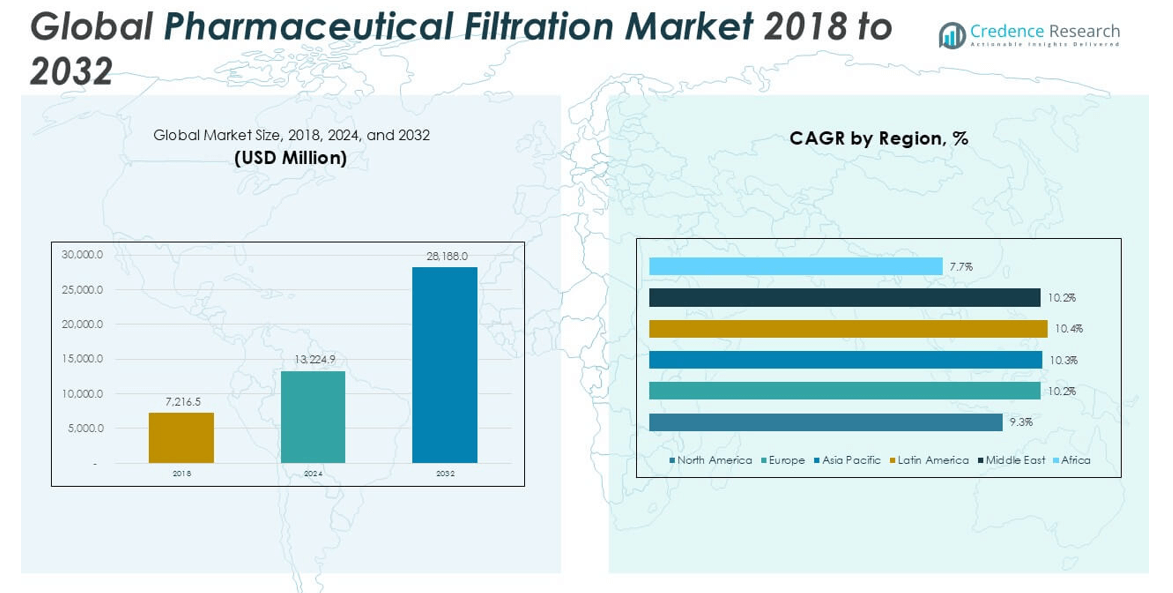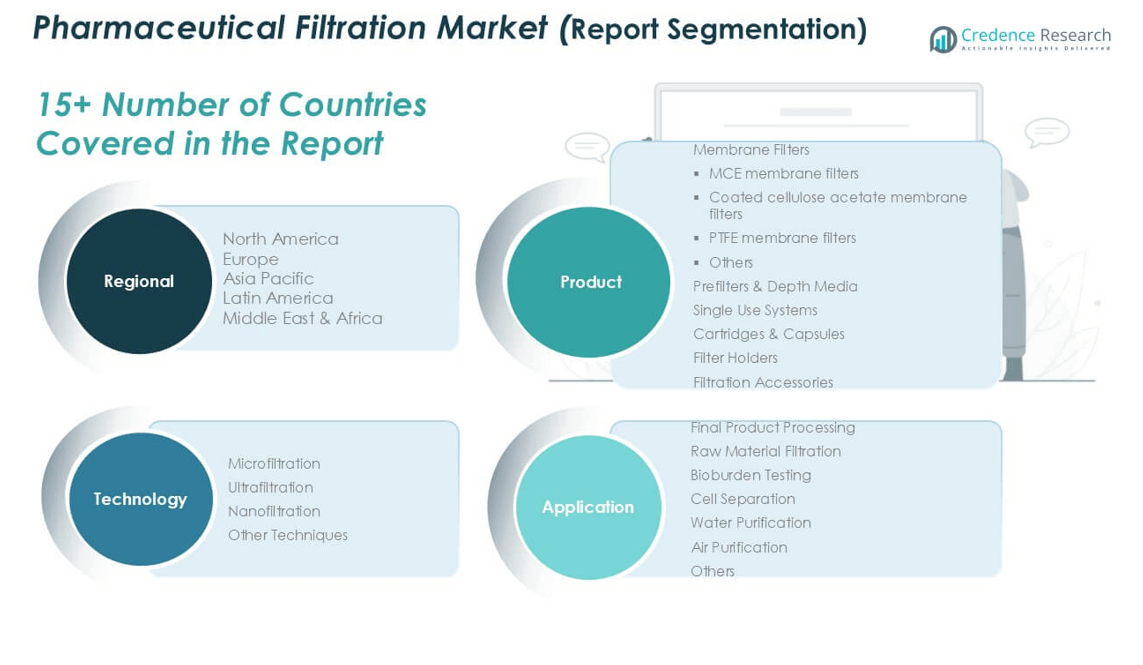CHAPTER NO. 1 : GENESIS OF THE MARKET
1.1 Market Prelude – Introduction & Scope
1.2 The Big Picture – Objectives & Vision
1.3 Strategic Edge – Unique Value Proposition
1.4 Stakeholder Compass – Key Beneficiaries
CHAPTER NO. 2 : EXECUTIVE LENS
2.1 Pulse of the Industry – Market Snapshot
2.2 Growth Arc – Revenue Projections (USD Million)
2.3. Premium Insights – Based on Primary Interviews
CHAPTER NO. 3 : PHARMACEUTICAL FILTRATION MARKET FORCES & INDUSTRY PULSE
3.1 Foundations of Change – Market Overview
3.2 Catalysts of Expansion – Key Market Drivers
3.2.1 Momentum Boosters – Growth Triggers
3.2.2 Innovation Fuel – Disruptive Technologies
3.3 Headwinds & Crosswinds – Market Restraints
3.3.1 Regulatory Tides – Compliance Challenges
3.3.2 Economic Frictions – Inflationary Pressures
3.4 Untapped Horizons – Growth Potential & Opportunities
3.5 Strategic Navigation – Industry Frameworks
3.5.1 Market Equilibrium – Porter’s Five Forces
3.5.2 Ecosystem Dynamics – Value Chain Analysis
3.5.3 Macro Forces – PESTEL Breakdown
CHAPTER NO. 4 : KEY INVESTMENT EPICENTER
4.1 Regional Goldmines – High-Growth Geographies
4.2 Product Frontiers – Lucrative Product Categories
4.3 Application Sweet Spots – Emerging Demand Segments
CHAPTER NO. 5: REVENUE TRAJECTORY & WEALTH MAPPING
5.1 Momentum Metrics – Forecast & Growth Curves
5.2 Regional Revenue Footprint – Market Share Insights
5.3 Segmental Wealth Flow – Product, Technology, and Application Revenue
CHAPTER NO. 6 : TRADE & COMMERCE ANALYSIS
6.1. Import Analysis By Region
6.1.1. Global Pharmaceutical Filtration Market Import Revenue By Region
6.2. Export Analysis By Region
6.2.1. Global Pharmaceutical Filtration Market Export Revenue By Region
CHAPTER NO. 7 : COMPETITION ANALYSIS
7.1. Company Market Share Analysis
7.1.1. Global Pharmaceutical Filtration Market: Company Market Share
7.2. Global Pharmaceutical Filtration Market Company Revenue Market Share
7.3. Strategic Developments
7.3.1. Acquisitions & Mergers
7.3.2. New Product Launch
7.3.3. Regional Expansion
7.4. Competitive Dashboard
7.5. Company Assessment Metrics, 2024
CHAPTER NO. 8 : PHARMACEUTICAL FILTRATION MARKET – BY PRODUCT SEGMENT ANALYSIS
8.1. Pharmaceutical Filtration Market Overview By Product Segment
8.1.1. Pharmaceutical Filtration Market Revenue Share By Product
8.2. Membrane Filters
8.2.1. MCE membrane filters
8.2.2. Coated cellulose acetate membrane filters
8.2.3. PTFE membrane filters
8.2.4. Others
8.3. Prefilters & Depth Media
8.4. Single Use Systems
8.5. Cartridges & Capsules
8.6. Filter Holders
8.7. Filtration Accessories
CHAPTER NO. 9 : PHARMACEUTICAL FILTRATION MARKET – BY TECHNOLOGY SEGMENT ANALYSIS
9.1. Pharmaceutical Filtration Market Overview By Technology Segment
9.1.1. Pharmaceutical Filtration Market Revenue Share By Technology
9.2. Microfiltration
9.3. Ultrafiltration
9.4. Nanofiltration
9.5. Other Techniques
CHAPTER NO. 10 : PHARMACEUTICAL FILTRATION MARKET – BY APPLICATION SEGMENT ANALYSIS
10.1. Pharmaceutical Filtration Market Overview By Application Segment
10.1.1. Pharmaceutical Filtration Market Revenue Share By Application
10.2. Final Product Processing
10.3. Raw Material Filtration
10.4 Bioburden Testing
10.5. Cell Separation
10.6. Water Purification
10.7. Air Purification
10.8. Others
CHAPTER NO. 11 : PHARMACEUTICAL FILTRATION MARKET – REGIONAL ANALYSIS
11.1. Pharmaceutical Filtration Market Overview By Region Segment
11.1.1. Global Pharmaceutical Filtration Market Revenue Share By Region
10.1.2. Regions
11.1.3. Global Pharmaceutical Filtration Market Revenue By Region
11.1.4. Product
11.1.5. Global Pharmaceutical Filtration Market Revenue By Product
11.1.6. Technology
11.1.7. Global Pharmaceutical Filtration Market Revenue By Technology
11.1.8. Application
11.1.9. Global Pharmaceutical Filtration Market Revenue By Application
CHAPTER NO. 12 : NORTH AMERICA PHARMACEUTICAL FILTRATION MARKET – COUNTRY ANALYSIS
12.1. North America Pharmaceutical Filtration Market Overview By Country Segment
12.1.1. North America Pharmaceutical Filtration Market Revenue Share By Region
12.2. North America
12.2.1. North America Pharmaceutical Filtration Market Revenue By Country
12.2.2. Product
12.2.3. North America Pharmaceutical Filtration Market Revenue By Product
12.2.4. Technology
12.2.5. North America Pharmaceutical Filtration Market Revenue By Technology
12.2.6. Application
12.2.7. North America Pharmaceutical Filtration Market Revenue By Application
12.3. U.S.
12.4. Canada
12.5. Mexico
CHAPTER NO. 13 : EUROPE PHARMACEUTICAL FILTRATION MARKET – COUNTRY ANALYSIS
13.1. Europe Pharmaceutical Filtration Market Overview By Country Segment
13.1.1. Europe Pharmaceutical Filtration Market Revenue Share By Region
13.2. Europe
13.2.1. Europe Pharmaceutical Filtration Market Revenue By Country
13.2.2. Product
13.2.3. Europe Pharmaceutical Filtration Market Revenue By Product
13.2.4. Technology
13.2.5. Europe Pharmaceutical Filtration Market Revenue By Technology
13.2.6. Application
13.2.7. Europe Pharmaceutical Filtration Market Revenue By Application
13.3. UK
13.4. France
13.5. Germany
13.6. Italy
13.7. Spain
13.8. Russia
13.9. Rest of Europe
CHAPTER NO. 14 : ASIA PACIFIC PHARMACEUTICAL FILTRATION MARKET – COUNTRY ANALYSIS
14.1. Asia Pacific Pharmaceutical Filtration Market Overview By Country Segment
14.1.1. Asia Pacific Pharmaceutical Filtration Market Revenue Share By Region
14.2. Asia Pacific
14.2.1. Asia Pacific Pharmaceutical Filtration Market Revenue By Country
14.2.2. Product
14.2.3. Asia Pacific Pharmaceutical Filtration Market Revenue By Product
14.2.4. Technology
14.2.5. Asia Pacific Pharmaceutical Filtration Market Revenue By Technology
14.2.6. Application
14.2.7. Asia Pacific Pharmaceutical Filtration Market Revenue By Application
14.3. China
14.4. Japan
14.5. South Korea
14.6. India
14.7. Australia
14.8. Southeast Asia
14.9. Rest of Asia Pacific
CHAPTER NO. 15 : LATIN AMERICA PHARMACEUTICAL FILTRATION MARKET – COUNTRY ANALYSIS
15.1. Latin America Pharmaceutical Filtration Market Overview By Country Segment
15.1.1. Latin America Pharmaceutical Filtration Market Revenue Share By Region
15.2. Latin America
15.2.1. Latin America Pharmaceutical Filtration Market Revenue By Country
15.2.2. Product
15.2.3. Latin America Pharmaceutical Filtration Market Revenue By Product
15.2.4. Technology
15.2.5. Latin America Pharmaceutical Filtration Market Revenue By Technology
15.2.6. Application
15.2.7. Latin America Pharmaceutical Filtration Market Revenue By Application
15.3. Brazil
15.4. Argentina
15.5. Rest of Latin America
CHAPTER NO. 16 : MIDDLE EAST PHARMACEUTICAL FILTRATION MARKET – COUNTRY ANALYSIS
16.1. Middle East Pharmaceutical Filtration Market Overview By Country Segment
16.1.1. Middle East Pharmaceutical Filtration Market Revenue Share By Region
16.2. Middle East
16.2.1. Middle East Pharmaceutical Filtration Market Revenue By Country
16.2.2. Product
16.2.3. Middle East Pharmaceutical Filtration Market Revenue By Product
16.2.4. Technology
16.2.5. Middle East Pharmaceutical Filtration Market Revenue By Technology
16.2.6. Application
16.2.7. Middle East Pharmaceutical Filtration Market Revenue By Application
16.3. GCC Countries
16.4. Israel
16.5. Turkey
16.6. Rest of Middle East
CHAPTER NO. 17 : AFRICA PHARMACEUTICAL FILTRATION MARKET – COUNTRY ANALYSIS
17.1. Africa Pharmaceutical Filtration Market Overview By Country Segment
17.1.1. Africa Pharmaceutical Filtration Market Revenue Share By Region
17.2. Africa
17.2.1. Africa Pharmaceutical Filtration Market Revenue By Country
17.2.2. Product
17.2.3. Africa Pharmaceutical Filtration Market Revenue By Product
17.2.4. Technology
17.2.5. Africa Pharmaceutical Filtration Market Revenue By Technology
17.2.6. Application
17.2.7. Africa Pharmaceutical Filtration Market Revenue By Application
17.3. South Africa
17.4. Egypt
17.5. Rest of Africa
CHAPTER NO. 18 : COMPANY PROFILES
18.1. Thermo Fisher Scientific, Inc.
18.1.1. Company Overview
18.1.2. Product Portfolio
18.1.3. Financial Overview
18.1.4. Recent Developments
18.1.5. Growth Strategy
18.1.6. SWOT Analysis
18.2. Merck KGaA
18.3. Graver Technologies
18.4. Danaher Corporation
18.5. 3M
18.6. Sartorius AG
18.7. Amazon Filters Ltd.
18.8. Koch Membrane Systems Inc
18.9. Meissner Filtration Products, Inc
18.10. Microdyn-Nadir US, Inc
18.11. Other Key Players





